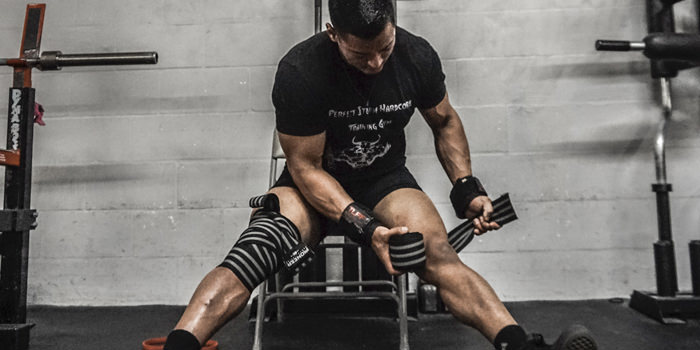
The average powerlifting career only lasts between five and ten years. There are many reasons for this, be it family or work obligations, injuries, or a loss of interest. In this article, I'd like to offer up some solutions to keep you going as life slows you down. But first, let's define aging because there is a significant difference between your actual and true age.
We all know what our true age is; how many years we've lived on this earth. Many people, however, are unaware of what a training age is. Simply put, training age is how long you've been training for a competitive sport. In many ways, your training age is more significant than your actual age. The main reason for this is sport-specific wear and tear that leads to imbalance, impingement, and injury. After tens of thousands of reps on any one movement, you can be sure that certain structures in your body will begin to fail. For some of us, this will take decades, and for others, just a few years. What I'm going to address here is how to maintain progress in powerlifting with an advanced training age.
Your first five years of powerlifting are the most fruitful. The gains come quickly, your body composition changes rapidly, and the associated confidence is intoxicating. This often spills over into other areas of your life, causing a net gain in quality of life. To be certain, you will experience plateaus and setbacks in this training phase, but they are infrequent and quickly addressed.
As you enter the second five-year period of training, you will more than likely find that the adversity increases. This is the period that typically catapults people to a higher level of competition. Most people will take a considerable amount of time to build a high level of absolute strength; this is why everyone at the top level will tell you they've been competing for ten or more years.
There is a ton of information out there for people in this training age bracket, but not so much for the aging lifter.
Ten+ Years of Powerlifting
This is where we pick up: ten or more years of competitive lifting. At this stage, you've developed a very respectable amount of strength and muscle. However, you've also probably accumulated your fair share of wear and tear, perhaps even some not-so-minor injuries. This is where training really starts to become problematic.
It's also the point in time for many lifters who've started in their late teens or early 20s to be entering a more demanding stage of life. People get married, have kids, progress in their careers, and generally have more things pulling them in more directions than just the gym, the kitchen, work, and bed.
Balancing work, life, and lifting can be a tall order, no doubt, but it can be done effectively with a little thought and effort. Having a set-in-stone training schedule and, even better yet, a training crew makes you much more likely to miss as few training sessions as humanly possible. This may require you to rise earlier and train in the morning or even later at night after work. But no one can determine the correct answer for you but yourself. Finding like-minded individuals will be a great help here; they will more than likely be facing a lot of the same life demands that you are, and will be willing to figure out a schedule that works for everyone.
As a young lifter, you may have time to come and go as you please, but a schedule and a crew become all the more important as you progress, and consistency becomes one of the biggest keys to your success.
Wear and tear are inevitable. I said it before, if you do anything with enough repetition, you will first become a master at it, then you will wear yourself out. However, there are some ways to mitigate this wear and tear.
The Four Rules
1. Use Conjugate Periodization.
Don't do the same shit over and over again; that's what wears you out. Instead, change the movements frequently and track your loading patterns to ensure you're not grinding yourself into the ground with set after set of heavy reps. By keeping the movements fresh and your body moving in different patterns, you are much less likely to wear things out.
Not only does this decrease the likelihood of pain and injuries, but it also keeps things new and exciting. Just think how good it would feel to actually look forward to each training session again and not feel like garbage in the process.
2. Focus on The Small Things.
When you're young and trying to build a stronger posterior chain for squatting and deadlifting, you may go months or even years without ever letting your knees travel over your toes or allowing yourself to go into thoracic extension. You may do the same thing on bench by never mobilizing your shoulders and consistently benching with your competition arch. Instead, you should be putting year-round effort into maintaining flexibility and dexterity.
You should be jumping, getting on the ground and moving around, increasing ranges of motion with light loads (think ATG method here). You should lunge, bend, and get into positions that you do not with the classic barbell lifts. This work is light, can be done quickly as part of your accessory work, and will yield benefits in joint health and proper anatomical function. And it can replace much of your heavy compound movement work that was more important to you as a younger lifter.
One of the main things that stop aging lifters from being able to showcase the strength they worked so long to develop is injuries and overall health. You're already strong, so get healthy so you can showcase that strength.
RECENT: The Urgency Of Meet Prep Training
3. Rest and Recover Often.
This is a controversial topic in some senses. Yes, we all know that rest and recovery are essential, but how important? And how do we properly prioritize them? I will tell you a secret I learned after all these years, and many of you won't like it; deload more frequently and back down your overall intensity.
After a decade-plus of competitive powerlifting, your muscles are very mature, your connective tissue is thicker and stronger, and your neuropathways are more efficient. All of this comes together to mean that you will maintain a higher level of strength with less traditional strength work.
I'm no genetic specimen, but I've taken months off of squatting or deadlifting and come back to lift 90%+ of my personal best in only a few weeks of training. It took me a long time to get comfortable with this because I, like most people, worry that my strength will escape me if I'm not constantly working on it. But the fact is, it's often been more beneficial for me to step away from the heavy shit and focus instead on some light accessory work to move blood and aid in recovery.
Make no mistake, your ability to recover suffers as you age, and I don't care how many drugs you're on; this is inevitable. So don't be afraid to take a step back and recover. You'll be amazed by how well it works.
4. Warm Up.
Yes, we all know that we must warm up before jumping into the heavy stuff. But I don't think many of us consider how much more warm-up is required when you have more miles on you.
I used to be able to come to the gym, do some leg swings, lightly stretch, then jump under the squat bar and start taking plate jumps to my working weights. Over time I learned it takes a lot more than that if I want to be primed and moving properly for the big weights.
At this current juncture in time, I do more than half of my "accessory work" before I start my main movements. The difference in my ability to move how I want to and generate force is undeniable. On a lower day, I might do the McGill Big 3, followed by Cat/Camels, Standing Leg curls, Reverse hypers, and Lat pulldowns. I'm not talking one set of each here either; I'm talking three to five sets of each movement with light weights for high reps to get everything lubed up and functioning properly.
This has been instrumental in helping me stay injury-free. There was a period before I learned this (and some of the other tricks I'm covering) when I was CONSTANTLY injured. I'm not talking about little tweaks here and there; I'm talking about torn muscles, severe tendinitis, and ruptured connective tissue that required surgical intervention.
Since implementing a more thorough warm-up that resembles an actual workout more than what many consider a warm-up, my injury rate has plummeted back to the levels of my first 5-10 years of competitive lifting. Get warmed up, truly warmed up, and ready for the beatings that ensue.
Conclusion
Hopefully, this article made you think outside the box a bit. Challenging what we know is an excellent tool for growth. I only wish I had made some of these realizations a bit earlier in my powerlifting career; I feel that I would have achieved even better numbers than I did.
Hopefully, you can put these tips and tricks to work for you and your training. I'd love nothing more than to get an inbox full of messages and emails with the positive results you all have encountered by implementing some of these tips and tricks.

Zane Geeting is a competitive powerlifter with over 20 years of experience. He has achieved both raw and equipped elite totals across three weight classes. Zane also coaches several elite lifters from across the US and Canada.










Thank You Sir
Ron